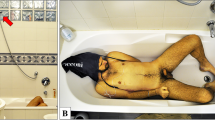Abstract
Hoarding is defined as the acquisition of, and failure to discard, possessions of little use or value to others, usually associated with a significant degree of clutter in the individual’s home. We describe a case of a woman who died from a combined traumatic and confined space asphyxia, after being trapped under some of the objects amassed in her apartment. The event was considered to be accidental; by taking into account the information gathered during assessment of the scene, we believe that the accident took place while entering or exiting the apartment. It appears that the woman, who was trying to open or close the door, could have been using her leg to keep the objects piled behind the door from falling. Unfortunately the pile of hoarded objects collapsed and the woman was fatally trapped underneath them. The age and strength of the woman played an important role in the fatal incident, she was too old and weak to remove the items that had collapsed over her body. The scarcity of space between the collapsed objects and the woman, as well as the absence of external or internal signs of violent asphyxiation, or other causes of death, allowed us to establish that the death resulted from a combined mechanism of both the traumatic and the confined space asphyxiation.

Similar content being viewed by others
References
American Psychiatric Association. Diagnostic and statistical manual of mental disorders. 5th ed. Arlington: American Psychiatric Publishing; 2013.
Williams M, Viscusi JA. Hoarding disorder and a systematic review of treatment with cognitive behavioral therapy. Cogn Behav Ther. 2016;45:93–110.
Weiss KJ. Hoarding, hermitage, and the law: why we love the Collyer brothers. J Am Acad Psychiatry Law. 2010;38:251–7.
Darke S, Duflou J. Characteristics, circumstances and pathology of sudden or unnatural deaths of cases with evidence of pathological hoarding. J Forensic Legal Med. 2017;45:36–40.
Karger B, Fracasso T, Pfeiffer H. Fatalities related to medical restraint devices-asphyxia is a common finding. Forensic Sci Int. 2008;178:178–84.
Shepherd R. Asphyxia. In: Shepherd R, editor. Simpson’s forensic medicine. 12th ed. London: Arnold; 2003. pp. 94–102.
Cecchi R, Aromatario M, Frati P, Lucidi D, Ciallella C. Death due to crush injuries in a compactor truck: vitality assessment by immunohistochemistry. Int J Legal Med. 2012;126:957–60.
Domènech MS, Alcázar HM, Pallarès AA, Vicente IG, García JC, Gutiérrez CV, et al. The murderer is the bed: an unusual case of death by traumatic asphyxia in a hotel folding bunk bed. Forensic Sci Int. 2012;220:e1–4.
Dolinak D, Matshes EW. Asphyxia. In: Dolinak D, Matshes EW, Lew EO, editors. Forensic pathology: principles and practice. Amsterdam: Elsevier Academic Press; 2005. p. 201–24.
Ferris JA. Asphyctic deaths. In: Siegel JA, Saukko PJ, Knupfer GC, editors. Encyclopedia of forensic sciences, vol. 1. London: Academic Press; 2000. p. 308–16.
Sauvageau A, Boghossian E. Classification of asphyxia: the need for standardization. J Forensic Sci. 2010;55:1259–67.
Di Maio DJ, Di Maio VJM. Forensic pathology. Boca Raton: CRC Press; 1993.
Frost RO, Steketee G, Tolin DF. Diagnosis and assessment of hoarding disorder. Rev Clin Psychol. 2012;8:219–42.
Coles ME, Frost RO, Heimberg RG, Steketee G. Hoarding behaviors in a large college sample. Behav Res Ther. 2003;41:179–94.
Steketee G, Frost RO, Kim HJ. Hoarding by elderly people. Health Soc Work. 2001;26:176–84.
Frost RO, Steketee G, Williams L. Hoarding: a community health problem. Health Soc Care Community. 2000;8:229–34.
Damecour CL, Charron M. Hoarding: a symptom, not a syndrome. J Clin Psychiatry. 1998;59:267–72.
Byard RW, Tsokos M. Forensic issues in cases of Diogenes syndrome. Am J Forensic Med Pathol. 2007;28:177–81.
Freeman A, Byard RW. Fatal hemorrhage from an undiagnosed rectal carcinoma in a case of Diogenes syndrome. Forensic Sci Med Pathol. 2014;10:116–8.
Irvine JD, Nwachukwu K. Recognizing Diogenes syndrome: a case report. BMC Res Notes. 2014;7:276.
Bloch MH, Bartley CA, Zipperer L, Jakubovski E, Landeros-Weisenberger A, Pittenger C, et al. Meta-analysis: hoarding symptoms associated with poor treatment outcome in obsessive-compulsive disorder. Mol Psychiatry. 2014;19:1025–30.
Honey L. Animal hoarding: not just an animal welfare issue. Vet Rec. 2014;174:569–71.
Byard RW. Death scene evaluation in hoarding disorders--Diogenes syndrome. J Law Med. 2013;21:66.
Author information
Authors and Affiliations
Corresponding author
Ethics declarations
Conflict of interest
The authors declare that they have no conflict of interest.
Ethical approval
Ethics approval was not required for this study.
Informed consent
Informed Consent was not required for this study.
Rights and permissions
About this article
Cite this article
Cappelletti, S., Cipolloni, L., Piacentino, D. et al. A lethal case of hoarding due to the combination of traumatic and confined space asphyxia. Forensic Sci Med Pathol 15, 114–118 (2019). https://doi.org/10.1007/s12024-018-0056-x
Accepted:
Published:
Issue Date:
DOI: https://doi.org/10.1007/s12024-018-0056-x




